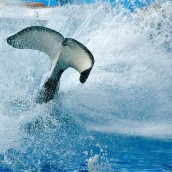Posted in Articles
4 Things Shamu Can Teach You About Stagecraft

I was obsessed with SeaWorld as a kid.
I went twice: first in Orlando when I was 6, and then again in Ohio when I was 8. (That location has since closed.)
I was fascinated by the animals, amazed by the pearl divers, and got my one and only fishing story about “the one that got away”. (I almost caught the largest trout in the fishing contest, but it slipped off the hook half-way out of the water.)
I sometimes wonder if those trips to SeaWorld were what made me fall in love with the ocean.
I even went on to study Ocean Engineering in college. (It took belly dance to lure me away.)
So earlier this month, when my husband and I went to Carlsbad, California for a wedding, we knew we had to go. We had a great time, but it wasn’t quite the marine wonderland I remembered. Maybe my memories were gilded with time. Or maybe the San Diego location was just smaller than the others.
But when we sat down to the “One Ocean” show, it all came flooding back.
And as I watched the show with performer’s eyes, I realized something:
Shamu knows a thing or two about stagecraft.
So let’s look at a few lessons we can learn from him…
1) Choose Moving Music
The music for the show was cheesy. Really cheesy. Laugh-out-loud cheesy.
And yet, as it swelled into the stadium, I still found myself getting teary-eyed.
As corny as it was, and as conflicted as I felt about seeing them in captivity, it still tugged on my heart-strings. and primed me to be awed by the graceful, powerful orcas swimming into view.
Lesson:
Before you start going through your iTunes library, think about what kind of feelings you want to create: Joy? Excitement? Party time? Mystery? Danger? Nostalgia?
Then be ruthless: if a song doesn’t strongly evoke that feeling, don’t use it for your show.
Tip:
Of course, you should still consider your audience. If you’re dancing at an Egyptian wedding, they’re going to expect Egyptian (or at least Arabic) music.
2) You Don’t Need a Million Moves
“One Ocean” has a lot in common with an old-school belly dance routine. It lasts about 25 minutes, and features 5 or 6 songs.
But the most interesting similarity is that the killer whales weren’t “kitchen sink” dancers. They used just a handful of flips, twirls, splashes, swimming, and poses, but still kept me captivated for almost half an hour.
Lesson:
It doesn’t take a lot of “stuff” to keep an audience’s attention. A few moves, done with care and joy, are way more interesting than cramming 7 different moves into a phrase.
Tip:
Instead of throwing in every move you know, focus on a few moves instead, and really “milk” each one.
3) Pacing Matters
I didn’t notice it until afterwards, but the show was very carefully paced. It began with an upbeat (but relatively simple) number, and then gradually built up to a crescendo with the entire gorup of orcas doing the most impressive feats. Then it ended with the whole group waving goodbye with their tails.
Lesson:
When you use fewer moves, the pacing is even more important. Start with a splash (get it? a splash?!?), but then include some emotional ups and downs. And don’t give away your most impressive material too early.
Tip:
Your biggest, most dramatic moment should go near the end, but shouldn’t be the very last thing you do. Always include some “resolution time”, so the audience can recover from the big moment, and say goodbye to you.
4) Audiences Love Participation
The seats in the “Soak Zone” of the arena fill up first. For many people, getting splashed is the highlight of their visit. (And the choreographers include several splashing combos in the show.)
But not just about getting wet. It’s about audience participation.
It’s fun because you’re being splashed by Shamu.
Lesson:
As a dancer, our primary job is to make the audience glad that they came. Audience participation is a wonderful way to do that, so don’t be shy about including it in your show.
Tip:
There are many different levels and types of audience participation. You can:
- Invite someone up to dance with you
- Go out into the audience for tips
- Do an old-school “sultan act” (depends on the audience)
- “Schmooze” with various audience members as you dance (i.e., go up to one person and dance just for them for a moment)
Summary
Some principles of stagecraft are universal. Choose music that will move your audience. Instead of throwing in everything you know, use a few moves to their fullest. To keep the audience’s interest, pace your show carefully. And include some form of audience interaction, to make them feel like they’ve experienced something, not just watched it.
Next Steps
Stagecraft lessons can be found in unexpected places, so keep your eyes open! Put a small notebook and pen in your purse. (Or learn how to use your phone’s memo feature.) When you see something interesting or enlightening jot it down before you forget.
Your Turn
Were you also obsessed with SeaWorld as a kid?
Have you ever learned stagecraft lessons in an unexpected place?
What are your top stagecraft tips?
Share your thoughts in the comments.
